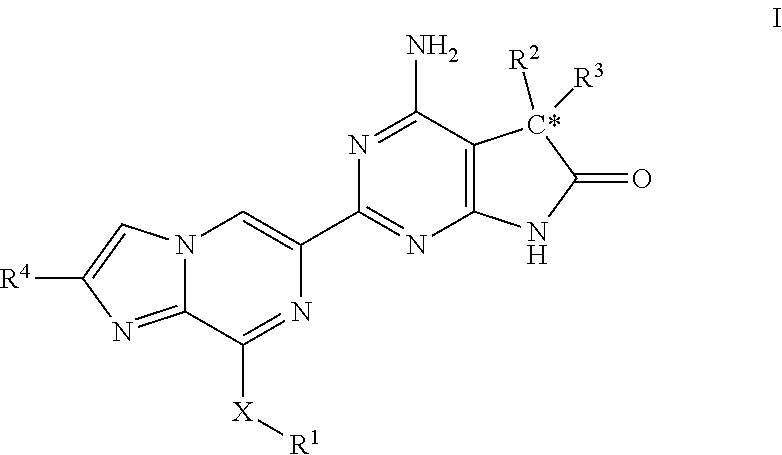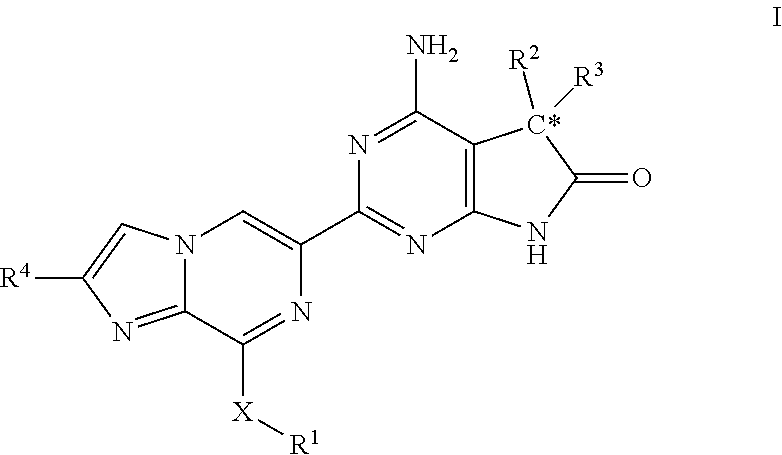Imidazo-pyrazinyl derivatives useful as soluble guanylate cyclase activators
a technology of guanylate cyclase and derivatives, which is applied in the direction of drug compositions, cardiovascular disorders, organic chemistry, etc., can solve the problems of reducing activity, reducing tolerance, and requiring a higher dosage, and mainly only having weak effects on the formation of cgmp in cell lysates
- Summary
- Abstract
- Description
- Claims
- Application Information
AI Technical Summary
Benefits of technology
Problems solved by technology
Method used
Image
Examples
example 1a
4-Amino-2-[8-(3-fluorophenoxy)imidazo[1,2-a]pyrazin-6-yl]-5-(4-fluorophenyl)-5-methyl-5,7-dihydro-6H-pyrrolo[2,3-d]pyrimidin-6-one
[0341]
[0342]Step A—6-Bromo-8-(3-fluorophenoxy)imidazo[1,2-a]pyrazine: In a vial was placed 6,8-dibromoimidazo[1,2-a]pyrazine (205 mg, 0.740 mmol), Cs2CO3 (482 mg, 1.481 mmol), 3-fluorophenol (73.7 μl, 0.814 mmol), and DMF (3.7 mL). After 20 min, the reaction mixture was diluted with EtOAc (50 mL), and the solid precipitate was filtered. The remaining eluent was concentrated in vacuo to dryness. The residue was dissolved in EtOAc, washed with water and brine. The organic layer was dried over anhyd.
[0343]Na2SO4 and filtered. The filtrate was concentrated in vacuo to dryness. The residue was purified by silica gel chromatography with EtOAc:hexanes (10-80%) to afford the title compound. m / z=309.8 (M+H).
[0344]Step B—8-(3-Fluorophenoxy)imidazo[1,2-a]pyrazine-6-carbonitrile: Into a vial was placed the intermediate from Step A (120 mg, 0.389 mmol), zinc cyanide (...
example 35a
4-Amino-2-(8-(3-fluorophenoxy)-2-(trifluoromethyl)imidazo[1,2-a]pyrazin-6-yl)-5-(4-fluorophenyl)-5-methyl-5H-pyrrolo[2,3-d]pyrimidin-6(7H)-one
[0347]
[0348]Step A—6,8-dibromo-2-(trifluoromethyl)imidazo[1,2-a]pyrazine: Into a flask, was placed 3,5-dibromopyrazin-2-amine (20.0 g, 79.1 mmol), DMA (100 mL), and 3-bromo-1,1,1-trifluoropropan-2-one (37.7 g, 197 mmol). The resulting solution was stirred 16 h at 90° C. The reaction was quenched by the addition of saturated sodium bicarbonate, and the resulting solution was extracted with EtOAc (3×). The combined organic layers were washed with brine (2×), dried over anhyd. Na2SO4, filtered, and concentrated in vacuo to dryness. The residue was purified by silica chromatography using EtOAc:PE (20%) to afford the title compound.
[0349]Steps B-E—4-Amino-2-(8-(3-fluorophenoxy)-2-(trifluoromethyl)imidazo[1,2-a]pyrazin-6-yl)-5-(4-fluorophenyl)-5-methyl-5H-pyrrolo[2,3-d]pyrimidin-6(7H)-one: The title compound was prepared utilizing the intermediate f...
example 39a
4-Amino-5-(4-fluorophenyl)-5-methyl-2-(8-propoxyimidazo[1,2-a]pyrazin-6-yl)-5,7-dihydro-6H-pyrrolo[2,3-d]pyrimidin-6-one
[0350]
[0351]Step A—8-(Methylthio)imidazo[1,2-a]pyrazine-6-carboximidamide: Into a flask, purged with an inert atmosphere of nitrogen, was placed 8-(methylthio)imidazo[1,2-a]pyrazine-6-carbonitrile (3.5 g, 18 mmol) and toluene (50 mL). To this was added amino(methyl)aluminum chloride (196 mL, 58.9 mmol, 0.3 M in toluene) and the resulting mixture was warmed at 80° C. After 16 h, the reaction mixture was cooled to 0° C. The reaction was quenched by the addition of MeOH:DCM (1:4, 200 mL). The solid was filtered through a pad of celite, and the resulting eluent was concentrated in vacuo to dryness to afford the title compound as the HCl salt.
[0352]Step B—4-Amino-5-(4-fluorophenyl)-5-methyl-2-(8-(methylthio)imidazo[1,2-a]pyrazin-6-yl)-5H-pyrrolo[2,3-d]pyrimidin-6(7H)-one: Into a vial, purged with an inert atmosphere of nitrogen, was placed t-BuOH (8.8 mL), the intermedi...
PUM
| Property | Measurement | Unit |
|---|---|---|
| body weight | aaaaa | aaaaa |
| temperature | aaaaa | aaaaa |
| pressure | aaaaa | aaaaa |
Abstract
Description
Claims
Application Information
 Login to View More
Login to View More - R&D
- Intellectual Property
- Life Sciences
- Materials
- Tech Scout
- Unparalleled Data Quality
- Higher Quality Content
- 60% Fewer Hallucinations
Browse by: Latest US Patents, China's latest patents, Technical Efficacy Thesaurus, Application Domain, Technology Topic, Popular Technical Reports.
© 2025 PatSnap. All rights reserved.Legal|Privacy policy|Modern Slavery Act Transparency Statement|Sitemap|About US| Contact US: help@patsnap.com



